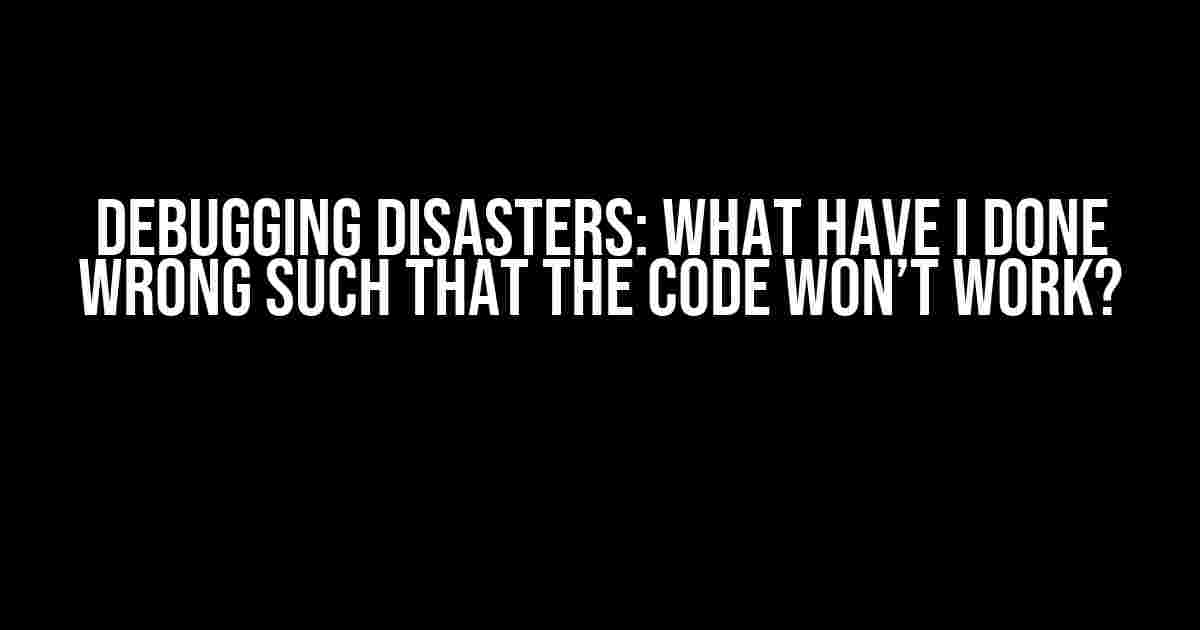Ah, the age-old question that has plagued even the most seasoned developers: “What have I done wrong such that the code won’t work?” Fear not, dear coder, for you are not alone in this struggle. In this article, we’ll delve into the most common mistakes that can lead to code conundrums and provide you with a step-by-step guide on how to identify and fix them.
Mistake #1: Typos and Syntax Errors
It’s easy to overlook a single character or miss a semicolon, but these tiny mistakes can bring your entire code to a grinding halt. Here are some common typos and syntax errors to watch out for:
Misspelled variable names: Double-check that your variable names match the ones you’re trying to reference.Missing or extra brackets: Ensure that your code blocks are properly closed and opened.Syntax errors in loops and conditionals: Make sure your loops and conditionals are correctly formatted and indented.Undefined or uninitialised variables: Declare and initialise your variables before using them.
To avoid these mistakes, it’s essential to:
- Use a code editor with syntax highlighting and auto-completion features.
- Enable warnings and error reporting in your code editor or IDE.
- Read your code out loud or explain it to someone else to catch any obvious mistakes.
Mistake #2: Logic Errors
Incorrect variable assignments: Ensure that you’re assigning the correct values to the right variables.Infinite loops: Use a debugger or add print statements to identify infinite loops and fix the termination conditions.Incorrect conditional statements: Double-check your conditional statements and ensure that they’re evaluating as expected.Unused or redundant code: Remove any unnecessary code that’s not contributing to the desired outcome.
To debug logic errors:
- Use a debugger to step through your code line by line.
- Add print statements or logging to identify variable values and execution flow.
- Simplify your code by breaking it down into smaller, more manageable functions.
Mistake #3: External Dependencies
When working with external libraries, APIs, or dependencies, it’s easy to encounter issues that can bring your code to a standstill. Here are some common mistakes to watch out for:
Outdated or incompatible dependencies: Ensure that you’re using the latest versions of dependencies and that they’re compatible with your code.Incorrect API usage: Read and follow the API documentation carefully to avoid mistakes.Network connectivity issues: Check your internet connection and API endpoints for any issues.
To avoid external dependency issues:
- Regularly update your dependencies to the latest versions.
- Read and follow the API documentation carefully.
- Test your API calls and external dependencies in isolation.
Mistake #4: Environment and Configuration
Sometimes, it’s not the code itself but the environment or configuration that’s causing the issue. Here are some common mistakes to watch out for:
Incorrect environment variables: Ensure that your environment variables are set correctly and match your code’s requirements.Inconsistent configuration: Double-check your configuration files and ensure that they’re correctly formatted and consistent across different environments.Missing or incorrect dependencies in the environment: Verify that all necessary dependencies are installed and configured correctly in your environment.
To avoid environment and configuration issues:
- Use a consistent and robust environment setup process.
- Document your environment variables and configuration files.
- Test your code in different environments and configurations.
Mistake #5: Lack of Testing and Debugging
Failing to test and debug your code properly can lead to a plethora of issues down the line. Here are some common mistakes to watch out for:
Inadequate testing: Ensure that you’re testing your code thoroughly and covering all edge cases.Lack of debugging tools: Familiarise yourself with debugging tools and techniques to identify issues quickly.Not reproducing errors: Ensure that you can reproduce the error consistently to identify the root cause.
To avoid testing and debugging issues:
- Write comprehensive tests for your code, including unit tests, integration tests, and end-to-end tests.
- Familiarise yourself with debugging tools and techniques, such as print statements, debuggers, and logging.
- Use a systematic approach to identify and fix errors, such as the scientific method.
Conclusion
Remember, debugging is not a one-time task, but an ongoing process that requires patience, persistence, and practice. So, the next time you find yourself wondering “What have I done wrong such that the code won’t work?”, take a deep breath, follow these guidelines, and you’ll be well on your way to fixing the issue and writing better code.
| Mistake | Symptoms | Solution |
|---|---|---|
| Typos and Syntax Errors | Code won’t compile, unexpected errors | Use code editor with syntax highlighting, enable warnings and error reporting, read code out loud |
| Logic Errors | Code runs but produces incorrect results | Use debugger, add print statements, simplify code, use logical reasoning |
| External Dependencies | API calls fail, dependencies not found | Update dependencies, follow API documentation, test API calls in isolation |
| Environment and Configuration | Code works in one environment but not another | Use consistent environment setup, document environment variables, test in different environments |
| Lack of Testing and Debugging | Code fails unexpectedly, issues difficult to reproduce | Write comprehensive tests, familiarise yourself with debugging tools, use systematic approach to identify and fix errors |
// Example code snippet to demonstrate a common mistake
function greet(name) {
console.log("Hello, " + nam);
}
// Fix: Correct the typo in the variable name
function greet(name) {
console.log("Hello, " + name);
}
Here is the HTML code for 5 Questions and Answers about “What have I done wrong such that the code won’t work?” :
Frequently Asked Question
Get to the root of the problem and troubleshoot your code with these commonly asked questions!
Did I forget to declare a variable or function?
Ah-ha! This is a common gotcha! Double-check that you’ve declared all variables and functions before trying to use them. If you’re still stuck, try commenting out sections of code to isolate the issue.
Are there any typos or syntax errors in my code?
Oops, it happens to the best of us! Take a closer look at your code for any typos, missing semicolons, or mismatched brackets. Your code editor or linter might be able to help you spot the errors.
Did I import the necessary libraries or modules?
Make sure you’ve imported all the required libraries or modules at the top of your code file. If you’re using a framework or library, check the documentation to ensure you’re following the correct implementation.
Am I using the correct data types and formatting?
Check that you’re using the correct data types for your variables and that your data is formatted correctly. For example, if you’re working with dates, ensure you’re using the correct date format.
Did I test my code in a different environment or browser?
Sometimes, code that works in one environment or browser doesn’t work in another. Try testing your code in a different environment or browser to see if the issue persists.


